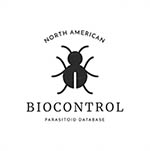scope of this catalog
A worldwide catalog on the biological control of weeds (www.ibiocontrol.org/catalog/) summarizes at the world level information on agents used for classical biological control of weeds and has been an immense help and valuable reference to researchers and practitioners of weed biological control for many years. The database "Biocat" of CABI in the UK is a parallel effort to summarize first releases of new agents for insect biocontrol, for all years and countries.
While Biocat's release to the public is planned, it has not been a publicly searchable database. Both the world weed biocontrol catalog and Biocat focus on the history of releases of agents, giving years and places of release at the country level, with notes on impact of the agent on the target pest. This new catalog builds on that experience, with direct and specific help from Matthew Cock (access to Biocat) and many individual researchers. It is focused on North America (Canada, the USA, and Mexico), with the separate tracking for the USA of four overseas regions as separate entities (Hawaii, Guam, Puerto Rico and the U.S. Virgin Islands).
This catalog expands on previous work by including information on host range estimation and literature host records, to give a sense of the likely specificity of each agent. It also includes information on synonyms of the agent's name to aid in understanding the literature. The records were assembled by the first author (RVD) from species-specific literature searches of the CAB abstracting database and other resources. The scope of the project is from 1985 to present, largely because in this period, persons working on most of the releases are still alive and were available to be contacted for clarification and unpublished information. This was done whenever possible (see list of scientists helping in effort in the Acknowledgement section).

what is included
The catalog's database has two types of entries, one for parasitoids and one for predators. Each entry represents a natural enemy x "country" release. In both types, the scientific name of the agent is given. In the subsequent columns, information is given on
- the year and place of first release in the political unit and where the agent was collected from
- the target pest
- information on host range testing and literature host records
- the release, establishment and impact of the agent
For all pieces of information, supporting citations are given for each individual statement, and references follow the dataset.
In addition, written statements have been prepared that summarize the information in specific lines of the database, species by species for each country of release. These written summaries provide a more readable presentation of most of the information found in the actual database.
Finally, we hope to link natural enemy names to a picture of each agent, if available. This will grow over time and at first some species will not be figured.
what is not included
This catalog is not intended to cover
- natural enemies of plants
- natural enemies of arthropods that are not themselves arthropods (no vertebrates or pathogens)
- natural enemies that were introduced to the country or location in question before 1985, unless they did not established and a second attempt was made after 1985
- species for augmentative use inside greenhouses
- species identified only as sp. plus a genus name (like Encarsia sp.) for which no complete name was subsequently associated with the entity introduced.
In some cases, exceptions (in favor of being inclusive) were made for species introduced into California (as a distinct ecoregion) from the eastern United States or for tracking several distinct source populations of a single species (as for example Cotesia rubecula Marshall), which was introduced three times from different sources with different outcomes, some of which preceded 1985 while others followed.
Also, this catalog, is unlike an earlier USDA effort under the name of ROBO, which tracked all releases of an agent, not just the first release. In this catalog, we are tracking only the first release of an agent into the "country or territory" (the entities being tracked separately as mentioned above).
how to cite the onlne database
To cite the catalog database: Van Driesche, R., M. J. W. Cock, R. L. Winston, R. Reardon, and R. D. Weeks, Jr. 2025. Catalog of Species Introduced into Canada, Mexico, the USA, or the USA Overseas Territories for Classical Biological Control of Arthropods, 1985 to 2018. USDA Forest Service, Forest Health Assessment and Applied Sciences Team, Morgantown, West Virginia. FHAAST-2018-09., USDA Forest Service, Forest Health Assessment and Applied Sciences Team. Available online at www.northamericanbiocontrol.com (Accessed 3/12/2025).
